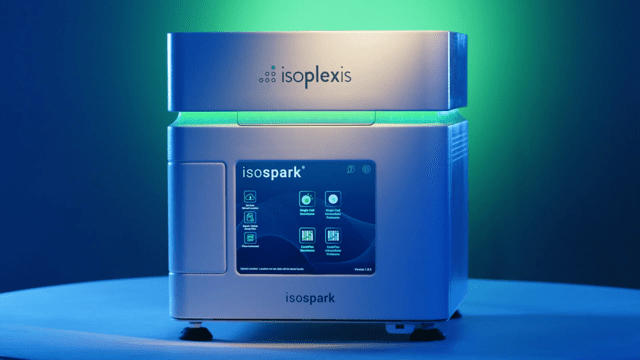Shares of IsoPlexis, a company creating tools to zoom in on the flurry of protein activity surrounding a single cell, began trading on Friday. The company aims to raise about $125 million with the IPO, which will be used to build the commercial team and advance the company’s plans to play a bigger part in the creation of precision medicine.
IsoPlexis was founded in 2013 and fits into the category of companies you might find in a lab during the drug research process. The company is primarily focused on single-cell proteomics (basically the study of proteins and their interactions). The company has developed instruments and software to analyze the proteins secreted by cells, from immune cells to tumor cells.
In particular, the instruments can be used to identify cells that excrete many different types of proteins. These data sets could then be used to develop new treatments or understand how people may respond to existing ones.
“Our instrument we invented is able to identity subsets of cells in the body we call superhero cells,” explains CEO and co-founder Sean Mackay. “And these superhero cells are defined by a lot of activity coming from small subsets of cells you would normally miss with existing technologies today.”
Mackay says there are about 150 IsoPlexis units on the market as of the first half of this year. Customers include 15 global pharmaceutical companies, and, per SEC filings, nearly half of the comprehensive cancer centers in the U.S.
IsoPlexis has raised a considerable amount of funding in the past from some notable investors.
Pre-IPO, the company had secured about $205.5 million in funding, per Crunchbase. The most recent Series D round totaled about $135 million in financing (about $85 million in equity securities and $50 million in debt financing), and included participation from Perceptive Advisors, Ally Bridge Group and “funds and accounts” managed by BlackRock.
Today, shares were initially priced around $15 each, but have slid to about $12 as of writing.
A major part of the IsoPlexis thesis is they’re the first to use proteomics and single-cell biology to link the function of cells to patient outcomes. Or in other words, among the first to show that we might be able to tell how well someone like a cancer patient may fare, by examining how individual cells and proteins interact.
There is published evidence that IsoPlexis’ instruments have been used to this effect, particularly when it comes to cancer treatments.
For example, one 2021 Nature Medicine study used IsoPlexis instruments to examine immune cell activity in lymphoma patients. These patients had cancers resistant to treatment, or that had returned after remission. Specifically, they were receiving CAR-T cell therapy — a form of treatment where genetically engineered immune cells are injected into a patient, where they then help target cancerous cells. Ultimately, the study found that cytokine production (proteins involved in cell signaling), by those CAR-T cells was an important indicator of how potent those CAR-T cells actually were.
In essence, it showed that IsoPlexis’ device might help uncover the signals that tell scientists how well CAR-T cell therapy was working.
“What we’ve seen is that the unique cells we identify are indicative of a long-term response in patients,” says Mackay. “We published studies in various cancers where, if patients have these types of unique immune cells, these superhero cells we detect, we know that those patients are going to have this long term outcome.”
For people particularly interested in the minutia of cells, IsoPlexis technology might sound similar to flow cytometry — a well-established method of counting cells, identifying them and measuring specific cell characteristics. There are some large established players in the flow cytometry world, like Thermo Fisher Scientific.
IsoPlexis, though, argues it can offer a whole new layer of information, largely protein-based information, that flow cytometry misses. The company has licensed an invention that allows the devices to barcode protein activity present in each individual cell (now called IsoCode). One Nature Reviews Chemistry paper suggests that barcoding is useful because it can analyze many different proteins at once, across thousands of cells, and cells can be recovered to be used in other experiments — but that this technology can still only capture a piece of the overall action of the proteome, so far.
“That new layer of data, for an individual cell is very different from the technology that is on the market today,” Mackay adds.
Still, the company has a long way to go before it can reach profitability. Per SEC documents, the company has been running at a loss for the past several years. Though the company pulled in $7.5 million in revenue in 2019 and $10.4 in 2020, it lost about $13.6 million and $23.3 million in those years, respectively.
Going forward, the path to growth largely means getting more instruments into more researchers’ hands.
“Our goal is to continue to move forward at a fast clip, expanding the same type of customers we have currently, but with more depth, and that’s really by continuing to build a commercial team,” he says.
